Sewing machine "Chaika-142M": features, use, repair
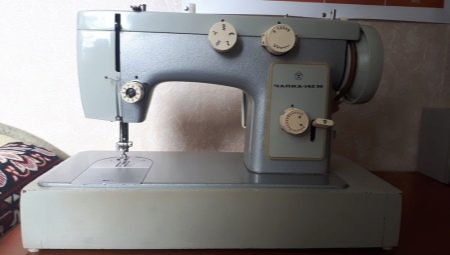
The sewing machine "Chaika-142M" - a legendary model produced during the Soviet era and enjoying great popularity, today is experiencing a rebirth. It is enough to find out how its modern and classic versions differ in order to say with confidence that this technique today fully corresponds to its status as a leader in the mass market segment. It is quite simple to operate it. The instruction manual for the equipment gives comprehensive recommendations and makes it easy to understand this issue.
Detailed guidance on setting and adjusting significantly simplifies the repair of the machine, if the breakdown is minor. It can help you figure out how to thread, attach a foot, or remove a pucker. Proper care of the chosen technique is also important. If all the rules were followed during its operation, serious problems during sewing can be avoided.
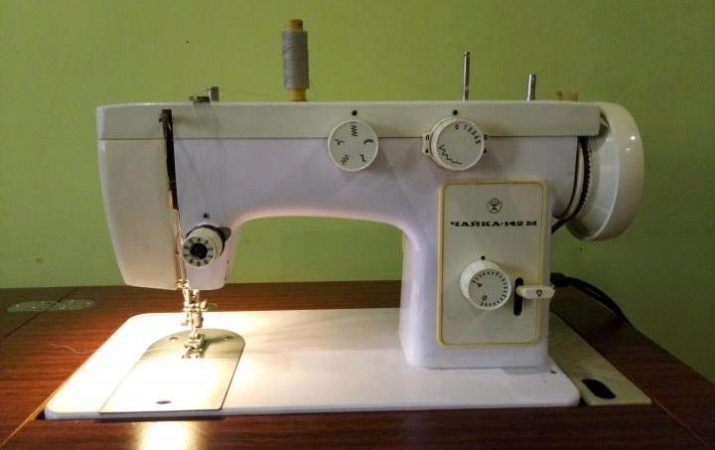
Specifications
The classic sewing machine "Chaika-142M" is one of the first models of Soviet sewing equipment, capable of performing many operations. It was produced in several modifications:
- 142M-22 and its versions - there is a table-cabinet, a foot drive;
- 142M-33 - with an electric drive, stand, suitcase;
- 142M-22-33 - combining the functionality of previous versions, with 2 types of drive mechanisms.
Depending on the drive, the machine is powered by a foot pedal or electrical energy. The weight of the 142M-33 model is 16 kg, of other modifications - 39 kg. The operating frequency of the machine is up to 1000 rpm, 12 sewing operations are available, the maximum width and stitch length are 4 and 5 mm, respectively.The foot rises to a height of 6 mm or more. The set includes an upper thread tension regulator, a thread cutter, a switch for sewing with a zigzag stitch.

The classic foot and electric machine "Chaika 142-M" does not require complex adjustment, but only periodic lubrication, since all parts of the mechanism are metal.
The equipment is adapted to work with silk, woolen, linen, cotton fabrics; when using a twin needle, decorative seams can be made.
The modern version of the Chayka 142M electromechanical sewing machine is produced in Vietnam. It is much lighter than its predecessor - only 5.7 kg. Its saved options include a vertical shuttle, reverse lever, foot lift with additional headroom for sewing heavy and thick fabrics. The indicators of length, stitch width, and the presence of an upper thread tension regulator remained the same.
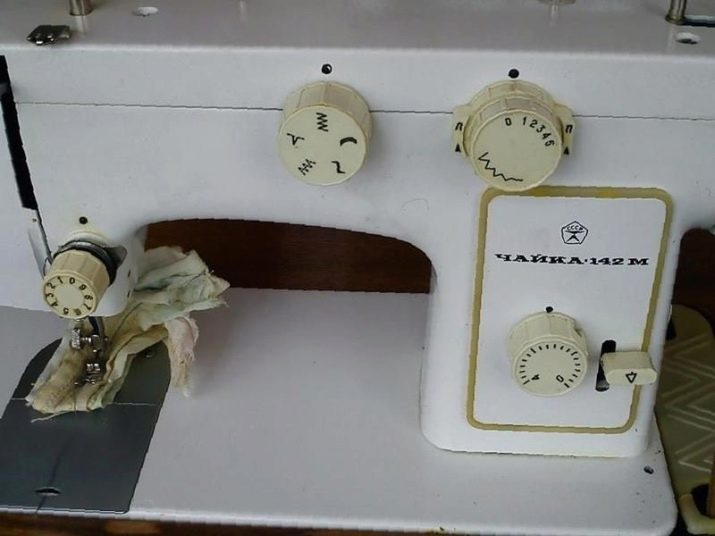
The differences include horizontal arrangement of the spool rod, increasing the number of available operations... Now there are 19 of them, in the presence of a buttonhole in the semi-automatic mode, the creation of overlock seams, knitted, elastic zigzag. The machine makes blind and decorative stitches. The straight stitch needle can be centered or shifted to the right.
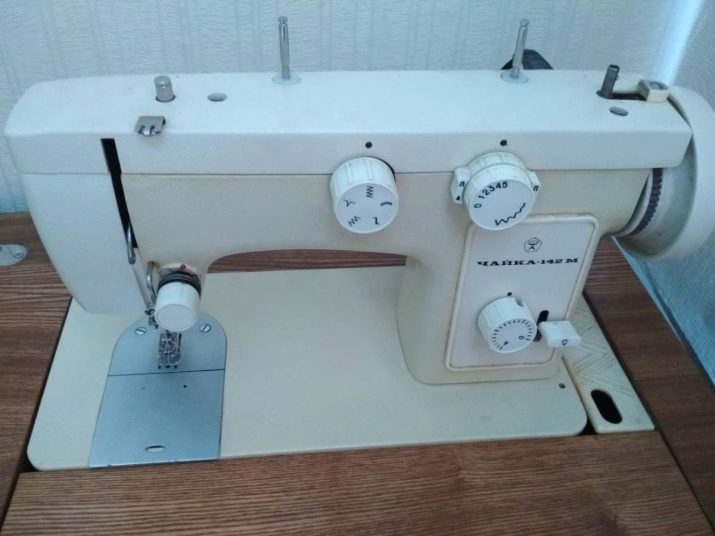
Equipment
The delivery set of the modern Chayka 142M sewing machine includes a soft cover that protects it from dust during storage, a soft felt pad. In addition, there is a device for ripping the fabric, a rod for fixing the spool in an upright position, as well as a small and large holder.
For adjustment and adjustment, the kit includes a wrench screwdriver, an oiler with lubricant. The manufacturer added accessories to the machine: a set of 3 needles, 4 plastic bobbins, a darning plate, a special guide for quilling, a frame for creating loops in a semi-automatic mode. Among the available feet: universal, designed for sewing in zippers, for sewing on buttons.
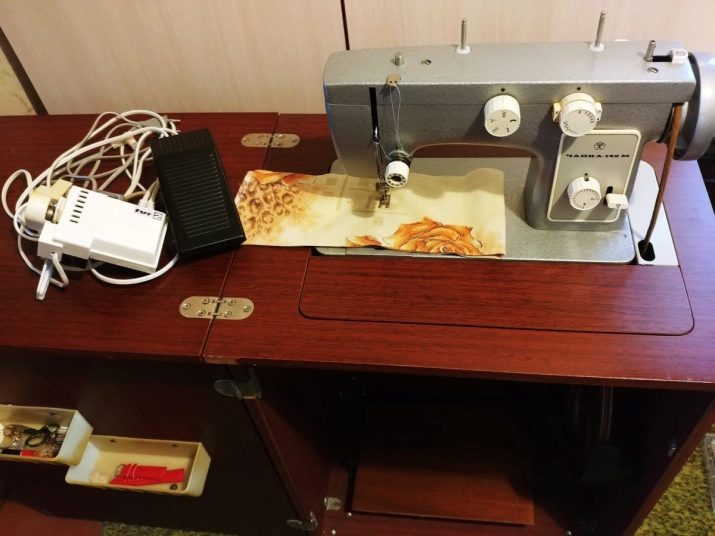
The Soviet model "Chaika-142M" also came with a set of accessories, consisting of:
- boxes for accessories;
- lubricators for lubricating mechanisms;
- 2 screwdrivers of different sizes for setting up equipment;
- 5 single and 3 double-pronged needles;
- darning plate;
- 4 bobbins;
- cleaning brushes;
- spare lamp;
- ripper and needle threader;
- 6 legs in addition to the universal;
- accessory for creating a blind seam.
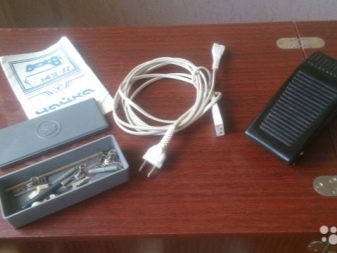
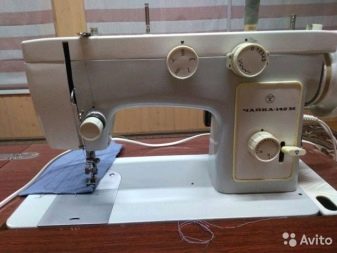
In addition, the set included a suitcase-cover or a table-wardrobe, depending on the modification of the machine. In general, we can say that the manufacturer today does not save on user convenience.
User manual
For describing the operation and setting of sewing machines "Chaika-142M" and Chayka 142M in comparison, it is worth considering from the very beginning equivalent modifications with an electric drive. Leg versions with a strap are not available today. Technique tuning and adjustment always starts with lubrication. All work is carried out strictly when the electric drive is off.
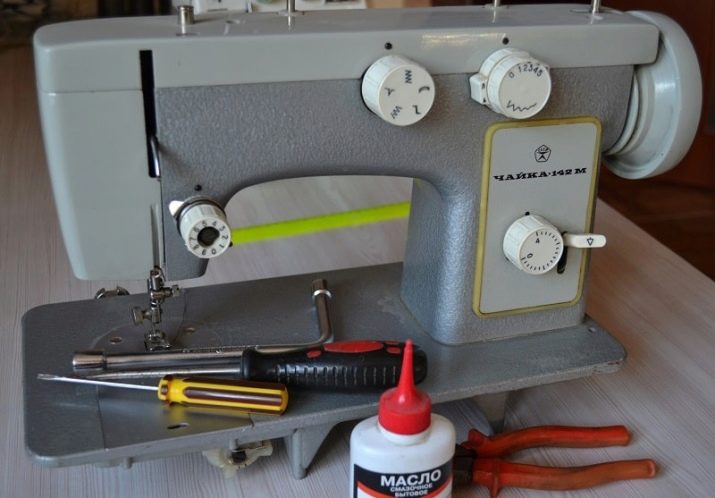
Threading
Before you start using the Chaika-142M sewing machine, you need to take care the correct threading. To do this, you need to set the needle in a position in which the thread groove will be directed towards the operator, and the sawn-off part of the flask will be turned in the opposite direction. When immersed in the plate, there should be no contact. If it happens, it is necessary to carry out positioning using the needle bar - its screws are loosened, the position is selected strictly in the center.
Then you can go directly to the threading. The lower one is on the bobbin and needs to be placed inside the bobbin case of the shuttle. It is taken out of the car before refueling. The bobbin is placed inside so that it rotates clockwise. The free end of the thread 10-15 cm long is passed through the slot, wound under the spring and fixed in a special groove, checking the freedom of rotation.

The upper tensioner is also refueled in a specific order, with the obligatory rise of the needle and the presser foot all the way up. After that, the rod, removed during storage, is pulled from the top from the body to install the coil, and it is placed in its place. Thread tip:
- extends through the guide from above;
- is carried out from right to left between the disc mechanism of the tension regulator;
- withdrawn into the eyelet in the lever;
- falls down through the spring;
- goes into the thread guide located in the needle bar;
- is threaded into the eye of the needle by hand or with a needle threader.
In the machines of the new model, part of the thread guiding mechanism is hidden in the body behind a special panel. The sequence of actions when refueling is shown in the explanatory figures right there, they do not need to be looked for in the manual.
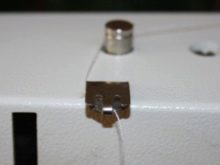
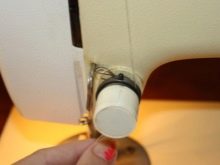
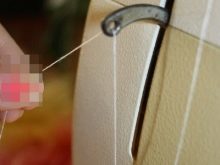
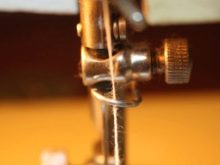
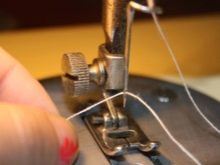
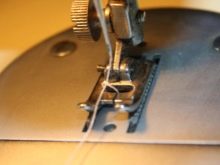
Thread winding
On older machines, the bobbin pin is located on top of the body, in the same place as the main spool. The thread is taken out of the dressing, passed through a special tensioner, manually fastened to the spool in several turns, installed on the fastener, pushed all the way. The flywheel is transferred to the idle position, after which the force from the drive is applied to the coiler and winding is carried out. When the bobbin is full, it will stop automatically.
On the machine of the new design, the winding of the thread takes place in a similar way. The whole scheme is printed on the body in the form of tips.

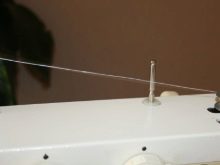
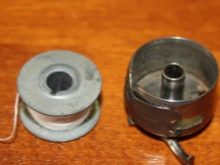
Control
To start sewing, select the desired stitch type on the left knob of the Chaika-142M machine control panel, and on the right knob set the mark “0” with the corresponding pointer along the central axis (corresponds to the position of the clock hands at “12”). The lower rotary controller sets the stitch length - it depends on the thickness of the fabric, increases in proportion to its growth. For working with materials of low density, a position of 1.5-2 mm is sufficient.
To change the sewing direction (reverse), move the lever to the right of the stitch length adjuster all the way down, perform a bartack and release. He himself will take up a regular position. A foot pedal is used to increase or decrease the RPM of the machine.
Changing the force when pressing it will give the desired effect. The pedal works only when the device is connected to the mains.
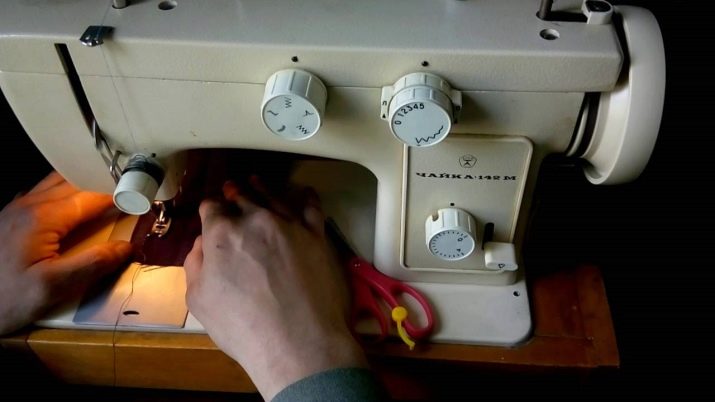
The lift of the lower conveyor teeth can be adjusted in the machine. For this, a plate is dismantled from the platform, which closes access to the shuttle compartment. When a regulator is found, it is placed in the desired position. The "B" mark is relevant for embroidery and darning operations (it is better to do it with a minimum zigzag step). The letter "H" is suitable for most materials, especially thin textiles are sewn in the "W" position.
In the new model, the reverse is on the panel closer to the needle bar hidden in the body. Regulators 2 and they are on top of each other... The upper one controls the stitch parameters, the lower one controls the stitch type.
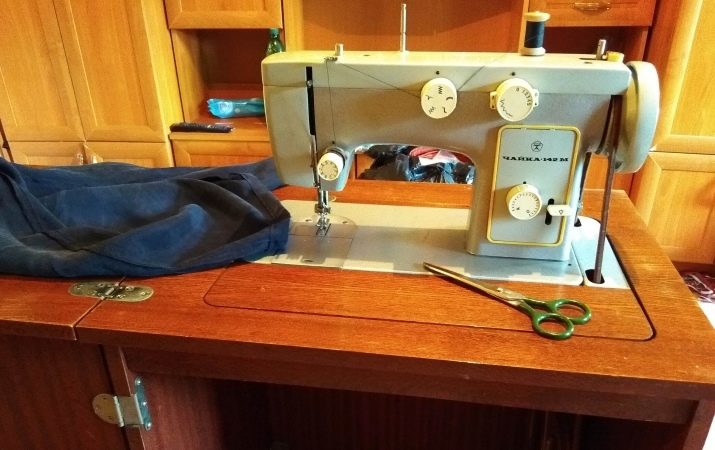
Care
In order for the sewing machine to perform as required, it needs proper care. It's worth starting with a visual inspection of the case... It is necessary to remove all visible dirt and dust from its surface. After that, you can proceed to dismantle the removable elements. In the old version, it was possible to remove the top cover, in the new one it is sealed, and access for lubrication of the mechanisms is presented in a limited volume.
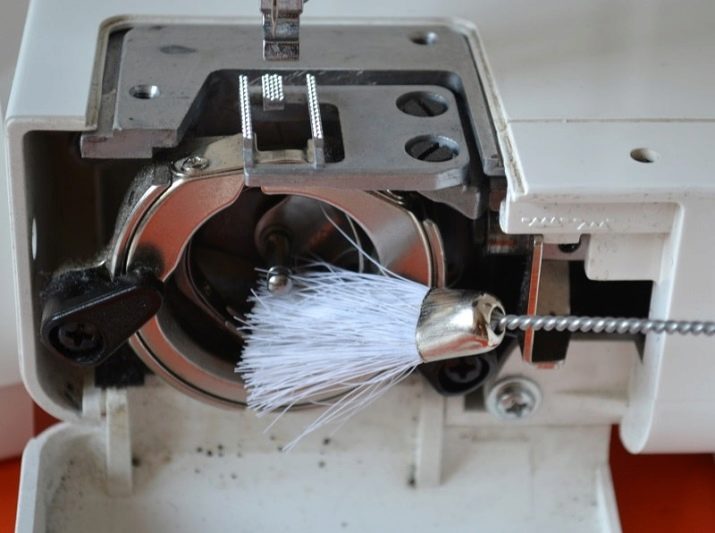
An obligatory moment in the care process is to clean the shuttle compartment from fabrics stuck in the towing mechanism. These works are carried out with the needle raised and fixed in the upper position. Also, it and the foot can be completely dismantled. Having freed access to the mechanism, you need to lubricate all rubbing parts with an oiler. Enough 2-3 drops for each node.
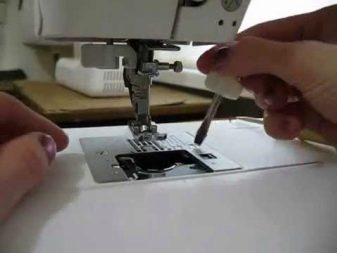
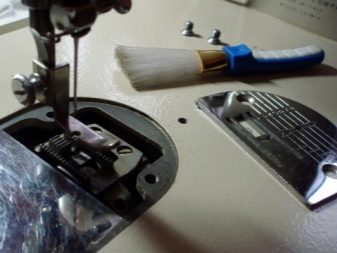
Possible malfunctions and repairs
The main reasons for the breakdown of modern Chayka 142M machines usually boil down to a violation of standard adjustments and settings. It is enough to return them to the factory values or correct them until the malfunction is eliminated.For example, if the thread tension is incorrect, the bottom stitch always loops or the chain of the top stitches is defective.
In old models of Chaika-142M machines, over time, the toothed belt of the electric drive breaks down or gets knocked off. If this happened, the main and lower shafts are out of sync. The line in this case will have traces of gaps. New cars also have this problem, and to correct the position of the belt, you have to dismantle the front panel of the case, since this part is hidden inside it.
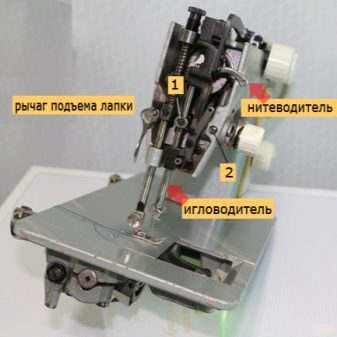

Other common problems include thread breakage. Among its causes are curvature and bluntness of the needle or its incorrect position. The needle bar may also be misaligned or the hook may be clogged with fleece. But most often the reason lies in the wrong thread tension.
And if in a modern machine it is regulated by special tuning units and requires only periodic removal of the debris accumulated between flat disks, then in old-style models, the adjustment is carried out manually.
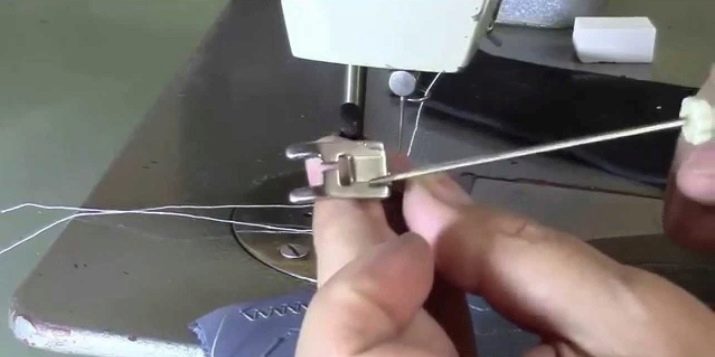
To begin with, a check line is made, which is necessary to identify the problem. If the seam has pronounced defects, it is recommended:
- check the correct position of the spool;
- check the filling of the upper tensioner;
- conduct an inspection for the detection of mechanical interference;
- check the type of needle and thread.
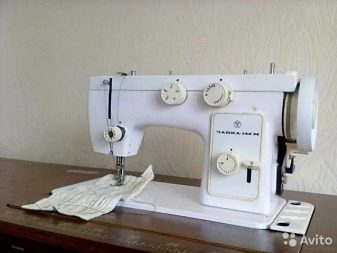
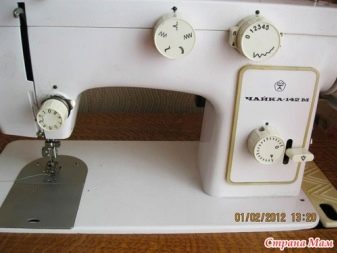
Not all defects can be fixed by yourself... If the stitching remains uneven when eliminating these problems, you need to contact the service center for diagnostics. The reason may be a manufacturing defect or a breakdown of a part of the mechanism.
If the matter is in the tension of the upper thread, it will be enough to loosen it by 0.5 steps. A test seam is then made. The adjustment continues until the result is satisfactory. If it's the bobbin thread, use a screwdriver to loosen the shuttle screw counterclockwise.
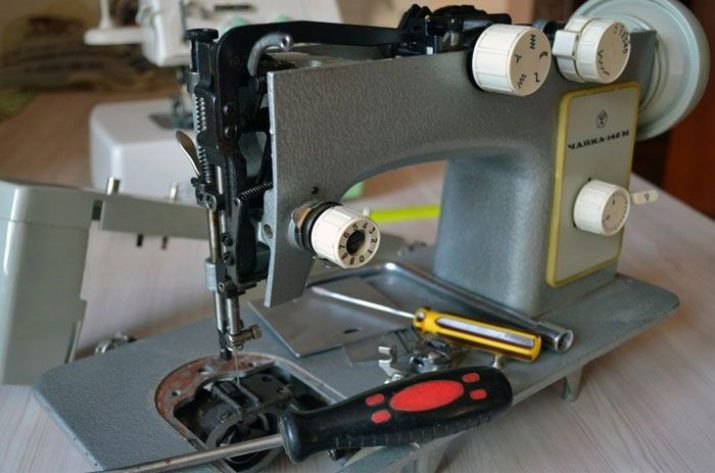
For possible types of sewing machine malfunctions, see the following video.









Hello. Tell me which electric drive belt is needed for this machine. I bought from hands without a belt, made a homemade one from leather, from a foot drive belt, cleaned, tuned - the machine is a beast. I want to buy a normal belt, but I can't find the exact information about the belt size. They write who is in what way. I would like to know for sure. Maybe you can advise which belt is better.